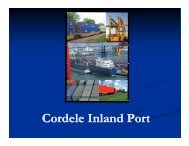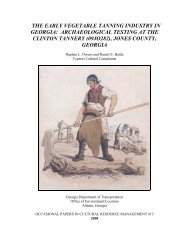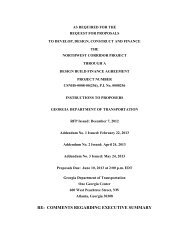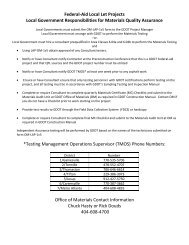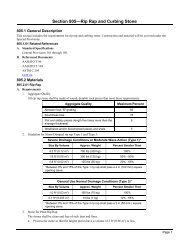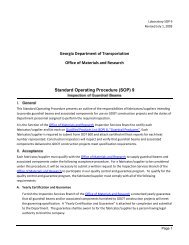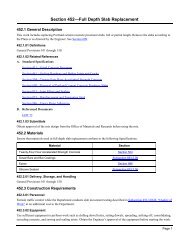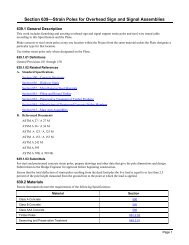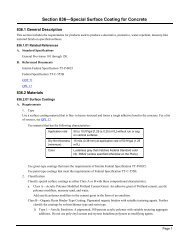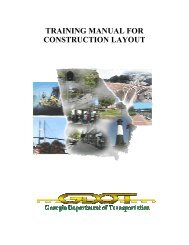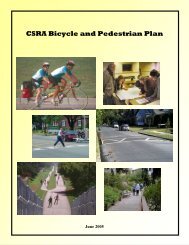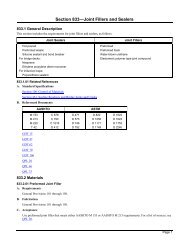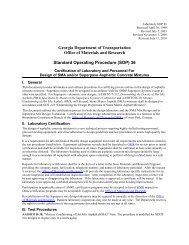Section 451 Patching Portland Cement Concrete Pavement (Spall ...
Section 451 Patching Portland Cement Concrete Pavement (Spall ...
Section 451 Patching Portland Cement Concrete Pavement (Spall ...
Create successful ePaper yourself
Turn your PDF publications into a flip-book with our unique Google optimized e-Paper software.
<strong>Section</strong> <strong>451</strong>—<strong>Patching</strong> <strong>Portland</strong> <strong>Cement</strong> <strong>Concrete</strong> <strong>Pavement</strong> (<strong>Spall</strong> Repair)<br />
<strong>451</strong>.1 General Description<br />
This work includes partial depth patching of spalls and potholes in <strong>Portland</strong> cement concrete pavement by removing the<br />
broken, damaged, or disintegrated concrete pavement. This work also includes removing asphaltic concrete patches from<br />
spalled or damaged areas of the pavement surfaces and patching them with approved patching materials according to this<br />
Specification and the existing pavement cross-sections.<br />
<strong>451</strong>.1.01 Definitions<br />
General Provisions 101 through 150.<br />
<strong>451</strong>.1.02 Related References<br />
A. Standard Specifications<br />
<strong>Section</strong> 504—Twenty-Four Hour Accelerated Strength <strong>Concrete</strong><br />
<strong>Section</strong> 800—Coarse Aggregate<br />
<strong>Section</strong> 801—Fine Aggregate<br />
<strong>Section</strong> 833—Joint Fillers and Sealers<br />
<strong>Section</strong> 886—Epoxy Resin Adhesives<br />
<strong>Section</strong> 934—Rapid Setting <strong>Patching</strong> Materials for <strong>Portland</strong> <strong>Cement</strong> <strong>Concrete</strong><br />
B. Referenced Documents<br />
QPL 27<br />
<strong>451</strong>.1.03 Submittals<br />
General Provisions 101 through 150.<br />
<strong>451</strong>.2 Materials<br />
Ensure that the materials used to repair and patch <strong>Portland</strong> cement concrete pavement conform to the rapid setting patching<br />
material requirements.<br />
The laboratory may waive the setting time requirements of approved materials if the minimum compressive strength<br />
development is unaffected.<br />
<strong>451</strong>.2.01 Delivery, Storage, and Handling<br />
General Provisions 101 through 150.<br />
<strong>451</strong>.3 Construction Requirements<br />
<strong>451</strong>.3.01 Personnel<br />
General Provisions 101 through 150.<br />
<strong>451</strong>.3.02 Equipment<br />
To clean the repair areas, use air compressors equipped with traps that can remove surplus water and oil in the compressed<br />
air. Ensure that the compressor can deliver compressed air at a continuous pressure of at least 90 psi (620 kPa).<br />
The Engineer will check the compressed air daily for contamination. Do not use contaminated air.<br />
Page 1
<strong>Section</strong> <strong>451</strong>—<strong>Patching</strong> <strong>Portland</strong> <strong>Cement</strong> <strong>Concrete</strong> <strong>Pavement</strong> (<strong>Spall</strong> Repair)<br />
<strong>451</strong>.3.03 Preparation<br />
A. Removing and Preparing the Repair Area<br />
Prepare to perform partial patching of spalled joints and potholes as follows:<br />
1. Partial Depth <strong>Patching</strong> of <strong>Spall</strong>ed Joints<br />
a. “Sound” each transverse joint and longitudinal joint with a visual defect to determine the limits of the damaged<br />
or defective areas. Strike the pavement surface along the sides of each joint with a hammer, chain drag, or<br />
similar tool to detect unsound concrete that sounds flat or hollow.<br />
b. Mark the limits of the defective areas on the pavement by making a rectangle 2 in (50 mm) beyond the outer<br />
limits of the unsound concrete area as a guide for sawing.<br />
c. Mark spalled areas less than 2 ft (600 mm) from each other along a joint as one spall area. If separated by 2 ft<br />
(600 mm) or more, mark as separate spall areas.<br />
Do not repair defective (spalled) joint areas less than 6 in (150 mm) long and 1.5 in (40 mm) wide under this<br />
Specification. Thoroughly clean and seal them with silicone sealant as part of the joint sealing operation<br />
specified in <strong>Section</strong> 461.<br />
d. Saw the rectangular marked areas with near vertical faces at least 2 in (50 mm) but not more than 3 in (75 mm)<br />
deep.<br />
e. Remove unsound material within the sawed area with a maximum 30 lb (135 N) chipping hammer.<br />
f. Do not damage or fracture the sound concrete substrate to be left on the bottom of the spall area. Do not use<br />
sharp pointed bits.<br />
g. If the unsound material is more than 4 in (100 mm) deep, the Engineer may direct a 6 ft (1.8 m) slab<br />
replacement be placed, which is classified and paid for under <strong>Section</strong> 609 and <strong>Section</strong> 452.<br />
h. Before placing the patching material, saw the face of the existing transverse or longitudinal joints bordering the<br />
repair areas. Saw at least 5 in (125 mm) deep and 0.25 in (6 mm) wide with the full depth of the saw cut<br />
extending at least 1 in (25 mm) beyond the limits of the repair areas in each direction.<br />
i. Immediately before placing the patching material, thoroughly clean the surfaces within the repair areas by<br />
sandblasting and air blasting to remove oil, dust, dirt, traces of asphaltic concrete, slurry from saw operation,<br />
and other contaminants.<br />
j. Place a 0.25 in (6 mm) wide piece of closed cell polyethylene foam shaped to fit the saw cut in the joints<br />
bordering the repair areas.<br />
If “back-to-back” repairs are made at a joint, support the 0.25 in (6 mm) closed-cell polyethylene foam during<br />
the placing operation to maintain a true, straight joint line.<br />
Have the Engineer approve the method used. The polyethylene foam must be supported in a straight line when<br />
the patching material is placed so a straight joint line will be formed.<br />
Maintain a straight line or the Engineer may require the repairs be repeated at no additional cost to the<br />
Department.<br />
2. Partial Depth <strong>Patching</strong> of <strong>Pavement</strong> Potholes<br />
The Engineer will determine which pavement potholes will be repaired.<br />
Use the procedures given for repairing spalled joints to repair potholes within the pavement surface. The<br />
requirement of using the 0.25 in (6 mm) closed-cell polyethylene foam does not apply.<br />
<strong>451</strong>.3.04 Fabrication<br />
General Provisions 101 through 150.<br />
Page 2
<strong>Section</strong> <strong>451</strong>—<strong>Patching</strong> <strong>Portland</strong> <strong>Cement</strong> <strong>Concrete</strong> <strong>Pavement</strong> (<strong>Spall</strong> Repair)<br />
<strong>451</strong>.3.05 Construction<br />
A. <strong>Concrete</strong> <strong>Patching</strong><br />
Patch concrete one lane at a time, safely and rapidly to minimize inconvenience to the traveling public.<br />
1. Accomplish the work with other operations in progress within an area if possible.<br />
2. Complete the work before the grinding operation begins, if grinding is specified.<br />
3. Remove and replace completed concrete patches that contain cracks, shrinkage, compression failures, or are<br />
damaged by construction or traffic before Final Acceptance at no additional cost to the Department.<br />
B. Placing <strong>Patching</strong> Material<br />
Use Repair Method 1 unless the State Materials Research Engineer gives written approval to use Repair Method 2. Use<br />
Repair Method 1 when the average daily temperature is 50 ºF (10 ºC) or above. Use of Repair Method 2, if approved, is<br />
limited to the manufacturer’s written recommendations.<br />
For the following repair methods, begin the placement when the surface within the repair area is dry and thoroughly free<br />
of contaminants.<br />
Ensure that the finished surface including joints meets a surface tolerance of 1/8 in (3 mm) per 10 ft (3 m).<br />
Use approved measures as necessary to keep pavement surfaces adjacent to this operation free of excess grout and other<br />
materials. Unless otherwise specified, complete the patching operations and open the lanes to traffic before sunset each<br />
day.<br />
1. Repair Method 1: Twenty-four Hour Accelerated Strength <strong>Concrete</strong><br />
Use this method as follows:<br />
a. Completely coat the concrete surface areas within the repair area with a film of Type II epoxy approximately<br />
10 to 20 mils (0.25 to 0.50 mm) thick.<br />
b. Mix the concrete on site in a portable mixer. Obtain approval for the mix design and mixing method from the<br />
laboratory. The material must meet a slump range of 1.0 in. (25mm) to 3.0 in. (75mm).<br />
c. Deposit the concrete in the repair area while the epoxy is still tacky. Vibrate it to form a dense, homogeneous<br />
mass of concrete that completely fills the patch area.<br />
d. Screed the concrete to the proper grade and do not disturb it until the water sheen disappears from the surface.<br />
e. Cover the concrete with wet burlap or membrane curing compound. Allow the curing to continue for at least<br />
three hours. The Engineer may require longer curing to ensure sufficient concrete strength development before<br />
opening to traffic.<br />
2. Repair Method 2: Rapid Setting <strong>Patching</strong> Material for <strong>Portland</strong> <strong>Cement</strong> <strong>Concrete</strong> <strong>Pavement</strong><br />
a. In addition to the requirements outlined in Subsection <strong>451</strong>.3.03.A, “Removing and Preparing the Repair Area,”<br />
prepare the surfaces in the repair areas according to the manufacturer’s written recommendations.<br />
b. Perform the patching material handling, mixing, placing, consolidating, screeding, and curing according to the<br />
manufacturer’s written instructions as approved by the laboratory.<br />
c. Continue curing for at least one hour and until opening the section to traffic.<br />
C. Special Requirements<br />
The following special requirements apply to this work:<br />
1. If repairing adjacent to an unstable shoulder, place a form the full depth of the repair area to maintain a true, straight<br />
shoulder joint and to prevent the patching material from intruding onto the shoulder area.<br />
2. After curing the patching material, remove the form and repair the shoulder at no cost to the Department.<br />
3. During sandblasting, protect traffic in the adjacent lanes.<br />
Page 3
<strong>Section</strong> <strong>451</strong>—<strong>Patching</strong> <strong>Portland</strong> <strong>Cement</strong> <strong>Concrete</strong> <strong>Pavement</strong> (<strong>Spall</strong> Repair)<br />
4. After the sandblasting operations:<br />
a. Thoroughly clean the area to be repaired with compressed air.<br />
b. Remove sand from the sandblasting operation from the roadway and shoulders.<br />
5. Do not “over-cut” the pavement beyond marked areas whenever possible.<br />
6. Remove saw slurry and other contaminates from the over-cutting.<br />
7. Repair the over-cuts by filling full-depth with an approved low-viscosity epoxy compound using a Type II epoxy<br />
adhesive specified in <strong>Section</strong> 886. Make these repairs as soon as possible, but not after the joint is resealed.<br />
8. Re-establish original transverse and longitudinal joints by sawing and sealing the joints with silicone that meets the<br />
requirements of Subsection 833.2.06, the Plan details, and <strong>Section</strong> 461.<br />
Re-establish the joints within 60 days after placing the patch. Ensure that re-established joints are at least 3/8 in (10<br />
mm) wide.<br />
<strong>451</strong>.3.06 Quality Acceptance<br />
General Provisions 101 through 150.<br />
<strong>451</strong>.3.07 Contractor Warranty and Maintenance<br />
General Provisions 101 through 150.<br />
<strong>451</strong>.4 Measurement<br />
The area measured for payment is the number of square yards (meters) of patching complete in place and accepted.<br />
<strong>451</strong>.4.01 Limits<br />
General Provisions 101 through 150.<br />
<strong>451</strong>.5 Payment<br />
The area measured as specified above will be paid for at the Contract Unit Price per square yard (meter). Payment is full<br />
compensation for equipment, tools, labor, incidentals to complete the work, including but not limited to:<br />
Removing existing asphaltic concrete patching material or the spalled, broken, or damaged <strong>Portland</strong> cement concrete<br />
Cleaning the open area by sandblasting<br />
Furnishing, placing, finishing, and curing the patching material<br />
Sawing and sealing new transverse and longitudinal joints<br />
Payment will be made under:<br />
Item No. <strong>451</strong> <strong>Patching</strong> <strong>Portland</strong> cement concrete pavement Per square yard (meter)<br />
<strong>451</strong>.5.01 Adjustments<br />
General Provisions 101 through 150.<br />
Page 4



